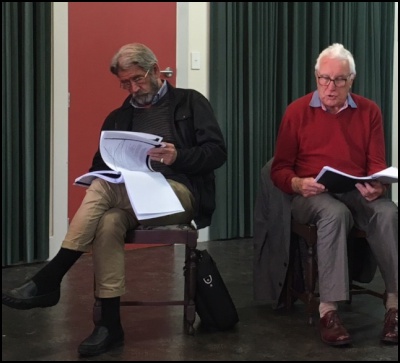King Lear at Circa
Review by Howard
DavisIn order to celebrate it's 40th birthday, it is perhaps fitting that Circa Theatre should pick a production of 'King Lear,' since it's also somewhat fortuitously Shakespeare's 400th anniversary. If some of the more cerebral poetry is lost in Michael Hurst's streamlined, full throttle production, it's more than made up for by plenty of lascivious violence designed to entertain the groundlings.
Scholars believe 'King Lear' was probably written around 1605, between 'Measure For Measure' and 'Macbeth.' Like 'Macbeth' and 'Cymbeline,' it has a specifically British rather than English or European setting, for explicitly political reasons. Two years earlier Elizabeth I and her court had retired to the royal palace at Richmond, where the Chamberlain's Men (presumably with Shakespeare among them) performed before her for the last time in early February. Soon afterwards, Elizabeth caught a chill, slipped into a dreamy, melancholy illness, and died, sixty-five and childless. It is therefore hardly surprising that Shakespeare's contemporaries would appreciate the significance of a play that deals directly with issues of inheritance and royal succession, especially as his new patron James I desperately wanted to unify the spasmodically warring kingdoms of England and Scotland into a peaceful union.

Ray Henwood as King Lear
Although Shakespeare lifted much of the story from Holinshed’s 'Chronicles,' Lear is also mentioned in Spencer’s 'Faerie Queene' and had already been dramatized a few years earlier as 'The True Chronicle of King Leir and his Three Daughters.' Shakespeare's version first appeared in quarto as 'The History of King Lear' in 1608, while the folio version entitled 'The Tragedy of King Lear' is a 1623 revision. For many years, editors tended to conflate the texts, but current scholarly practice is to analyze them to separately. Astonishingly, Nahum Tate’s hugely popular version of 'King Lear,' which was performed regularly from 1681 to 1843, gave the play a happy ending.
Fortunately, perhaps, that is no longer the case. The
Circa production explores the play's twinned themes of sight
and insight, pride and ignorance, blindness and madness,
chaos and darkness with a uniformly somber palette, which
makes the shedding of blood (when it comes, as we know it
must) all the more shocking. For this tragic drama is also a
heightened melodrama - a family romance in which the
extremities of civil war (treachery and torture, sex and
murder, betrayal and forgiveness) are all portrayed in
extremis. Director Hurst (who himself played the Fool in a
recent Auckland production) comments - "as we unpacked the
action in rehearsals, we kept opening enormous caverns of
significance, where the play seems to reach beyond its
verbal confines."
Which is, of course, precisely the reason why Shakespeare's tragedies remain so relevant and timely even today. The violence deployed by Macbeth as he desperately clings to power has been duplicated in the actions and behavior of any number of petty dictators, not least in Russia. Hamlet's dithering equivocations have plagued many a troubled, love-struck adolescent bent on self-destruction and revenge. And all the elements of the OJ Simpson story were already present in 'Othello,' three centuries earlier. Shakespeare's great quartet of tragedies depict moral dilemmas whose contemporary consequences are plastered over today's headlines on a daily basis.
As we watch the lugubrious and somewhat abbreviated action unfold with pre-ordained precision, we also become aware that we're witnessing a theatrical torch being passed from grizzled veterans such as Ray Henwood (Lear) and Ken Blackburn (Gloucester) to a younger generation.

Ray Henwood (Lear) and Ken Blackburn (Gloucester) in rehearsal - over 100 years of acting experience!
Carmel McGlone as
Goneril and Claire Waldron as Regan are suitably maleficent,
while Guy Langford and Andrew Patterson are magnificently
matched as the rivalrous siblings Edmund and Edgar. The set
and lighting design by Andrew Foster and the mid-C20th
costumes by Gillie Coxhill are subtly shaded in subdued hues
of grey, brown, olive-green, and khaki. Jason Smith's
minatory sound design effectively complement the production,
without overwhelming it. If Gavin Rutherford's Fool seems
slightly too autistic, it doesn't detract from a genuine
ensemble production in which the significance of the
sub-plots are elevated so that their doubling of the main
themes are clearly reiterated: "nothing comes from nothing"
and "men must endure their going hence even as their coming
hither - ripeness is
all."



 Martin LeFevre - Meditations: Psychedelics, Mystical Experiencing, And Organized Religion
Martin LeFevre - Meditations: Psychedelics, Mystical Experiencing, And Organized Religion Keith Rankin: Equity Rights - UBI, SUI, BUI, HUI, Or GUI?
Keith Rankin: Equity Rights - UBI, SUI, BUI, HUI, Or GUI? Binoy Kampmark: The Inevitable Souring - Elon Musk Falls Out With Donald Trump
Binoy Kampmark: The Inevitable Souring - Elon Musk Falls Out With Donald Trump Ian Powell: Postscript On Ethnic Cleansing, Genocide And New Zealand Recognition Of Palestine
Ian Powell: Postscript On Ethnic Cleansing, Genocide And New Zealand Recognition Of Palestine Gordon Campbell: On Why Leakers Are Essential To The Public Good
Gordon Campbell: On Why Leakers Are Essential To The Public Good Ramzy Baroud: Global Backlash - How The World Could Shift Israel's Gaza Strategy
Ramzy Baroud: Global Backlash - How The World Could Shift Israel's Gaza Strategy